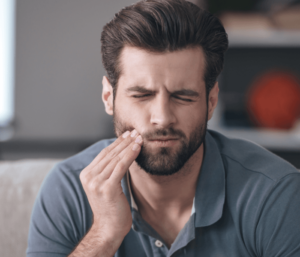A BASEBALL LESSON
June 27, 2022
 Baseball season is in full “swing” this season with many kids playing throughout the summer. Here’s a lesson about why it’s important to protect your teeth no matter what you are playing.
Baseball season is in full “swing” this season with many kids playing throughout the summer. Here’s a lesson about why it’s important to protect your teeth no matter what you are playing.
In the spring of 1939, in celebration of the 100th year anniversary of baseball, catcher Joe Sprinz of the Pacific Coast League’s San Francisco Seals announced that he would attempt to establish the world record for catching a baseball dropped from the highest height ever — 800 feet. It would occur during a baseball game before a crowd of 15,000. Coincidently it was Sprinz’s 37th birthday too.
Five balls were to be dropped from the Goodyear blimp hovering overhead. Sprinz missed the first four balls. But on the fifth, the blimp’s captain, A. J. Sewell (an ace bomber pilot during World War I), said he “thought that Sprinz had it.” He added, “From the ship [blimp] it looked as if it hit his glove first. … He walked quite a ways and then sat down. Then some persons crowded around him and we saw him lying down.”
A University of California mathematician calculated the ball was traveling at 145 miles an hour when Sprinz made his catch. The force of the ball gathered as it descended from the blimp, tearing Sprinz’s hands apart, causing the ball to crash against his face. Sprinz had knocked out eight teeth, fractured his upper jaw, broke his nose, and severely lacerated both lips.
The following day, Sprinz “murmured” through his hospital bandages and a wired jaw reflecting on what happened: “I had the ball judged all the way. The ball hit my glove. … [It] didn’t hit my face. The jar of the ball drove the mitt back against my mouth and caused all the damage.”
“Most of the eight teeth lost were bridgework and can be replaced,” his doctor noted. Sprinz chimed in that he was more hurt and baffled by his failure to hold onto the ball “than he is hurt by his hurts.” He returned the following year in May 1940 as the starting catcher for the Seals, claiming he was “just as good” as he was before the accident.
After his retirement from baseball in 1942, he worked with the Seals back office and later with little leagues and the San Francisco Parks and Recreation Department, developing intercity baseball. Sprinz died in 1977 in San Francisco. He was 91.
Sprinz’s catch was officially recorded in the Guinness Book of World Records as the World’s Highest Catch in 1994.
In 2013, baseball sportswriter Zack Hample decided to break Sprinz’s record. He accomplished the feat in July 2013, catching a baseball dropped from a helicopter at 1,050 feet. Unlike Sprinz — and maybe because of him — Hample wore protective gear, including a catcher’s mask, hard-shell protective headgear, and breast plate. Nobody from the Guiness World Record organization attended, although invited. Hample lost no teeth. Officially, Sprinz still holds the record.
Lesson #1: Don’t’ try to catch a baseball dropped from any flying machine; it’s not worth it.
Lesson #2: Baseball is not considered a contact sport but there are many ways “contact” can be made with the mouth. Despite the fact that mouthguard protection is not the “in” thing to do when plying baseball, I highly recommend it.
Dr. St. Clair maintains a private dental practice in Rowley and Newburyport dedicated to health-centered family dentistry. He has a special interest in treating snoring, sleep apnea and TMJ problems. If there are certain topics you would like to see written about or questions you have, please email them to him at jpstclair@stclairdmd.com
INFO FOR NEW MOMS
June 20, 2022
The key to a child’s good dental health begins before his or her teeth become visible. Here are some answers to some of the most frequently asked dental health questions relating to pregnancy, infants, toddlers and children.
- Does being pregnant affect my oral health? Yes… hormonal changes exaggerate the way gum tissues react to the irritants in plaque. Thorough brushing and flossing of your teeth twice daily to remove the plaque and eating a balanced diet will help to keep your gums healthy.
- Should I visit my dentist during my pregnancy? Yes… you should continue regular dental visits. However, it is very important to let your dentist know that you are pregnant. You may be asked to be seen more frequently.
- Are x-rays safe during pregnancy? Yes… x-rays are safe during pregnancy and are a vital tool used in helping to detect dental and other oral health problems. Only the x-rays that are necessary for treatment will be taken. You will be asked to wear a lead apron for extra protection.
- 4. When will my infant begin to get teeth? Tooth eruption varies from infant to infant. However, most infants will start to get teeth around six to 12 months of age.
- When should I begin to brush my infant’s teeth? Starting at birth, clean your infant’s gums with a soft infant toothbrush, cotton gauze, or cloth and cool water. For infants under two years of age, parents should consult their child’s dentist before introducing a fluoride toothpaste.
- How much fluoridated toothpaste should I use when brushing my child’s teeth? Beginning at 2 years of age, a pea-sized amount of fluoridated toothpaste should be used during brushing. Children should be encouraged to spit, not swallow, toothpaste, and the amount of toothpaste used can be increased after five or six years of age when the child can reliably do this.
- When should I take my baby in for his/her first dental visit? This varies among practitioners. Consult your family dentist. In the meantime, look into the child’s mouth on a regular basis to make sure you don’t see anything unusual.
- How can I prevent my infant from getting early decay, know as early childhood caries or baby bottle tooth decay? When placing your infant down to sleep (nap or nighttime), place only water in the bottle. Sugary liquids like formula, breast milk, juice and soda can pool around the infant’s teeth and cause decay. Don’t forget to clean or brush your infant’s gums/teeth twice daily to remove food and plaque.
- What else can I do to keep my child’s teeth healthy? Children are not born with the bacteria that cause decay. They are exposed to these bacteria from their caregivers, especially their mothers. By keeping your teeth healthy and free from decay, you can help reduce your child’s exposure to these bacteria and reduce the chances of early decay.
- What can I do to help my baby through teething? Many babies like a teething ring, cool spoon, or cold wet washcloth. Some parents/care providers rub their infant’s gums with a clean finger.
Dr. St. Clair maintains a private dental practice in Rowley and Newburyport dedicated to health-centered family dentistry. He has a special interest in treating snoring, sleep apnea and TMJ problems. If there are certain topics you would like to see written about or questions you have, please email them to him at 
DENTAL EMERGENCY
June 13, 2022
 In a recent study published by the American Dental Association (ADA), visits to the emergency room (ER) for dental related issues have doubled nationwide over the last decade. Last year, over 2.1 million people visited the ER for a dental “emergency”, most of which could have been prevented with regular dental visits.
In a recent study published by the American Dental Association (ADA), visits to the emergency room (ER) for dental related issues have doubled nationwide over the last decade. Last year, over 2.1 million people visited the ER for a dental “emergency”, most of which could have been prevented with regular dental visits.
In another recent collaborative study between the Rutgers School of Dental Medicine and the Rutgers Center for State Health Policy, they confirmed that most of these ER visits were for dental pain and infections that were not related to trauma. This is an increasing burden on the taxpayer and the healthcare system. ER visits can be 10 times more costly than if the treatment was performed in a dental office.
Dr. Cecile Feldman, dean of the Rutgers School of Dental Medicine, recently said the following in an ADA publication:
“The most disturbing aspect of the rise in ER dental visits is that treatment is often ineffective. In emergency rooms, there is a lack of diagnostic equipment and tools – such as dental X-ray machines – and ER physicians aren’t trained to identify and treat oral health problems. Often, they prescribe painkillers and antibiotics for infections while the underlying problem remains.”
The increase in dental ER visits supports the fact that many Americans have inadequate knowledge about the consequences of not getting regular dental check-ups. Many view dental care as a luxury and if their teeth don’t hurt and appear visually acceptable, they do not feel the need to visit a dentist.
Dental decay is the underlying cause of most ER dental visits. Dental decay does not hurt until it has affected the nerve of the tooth. Dr. Feldman states, “Tooth decay, which is almost entirely preventable, is the most common chronic illness among school-age children. Left untreated, it can result in infection, unbearable pain, loss of teeth and acute systemic infection, which in some cases can lead to death. Yet nearly one in four American children has untreated tooth decay.”
So, what are some of the underlying reasons for the increase in ER visits? Dr. Feldman says, “For many, a visit to the dentist is unaffordable and inaccessible. More than 85 million Americans have no form of dental insurance. For those who have Medicaid, finding a dentist who accepts it can be challenging. Many dentists don’t because the reimbursement payments are a fraction of the cost of care and there is a very high administrative burden.”
I have seen many suggestions for helping address this problem. Some push for more community water fluoridation, others for dental coverage for all. While children do have coverage under some medical insurance plans, it does not extend to adults. I’m not so sure that is the answer anyway, mainly due to the cost.
Dental insurance, in general, is a broken system. Unless there is some major overhaul in the way dental care or dental insurance is delivered in this country, the ER stats will continue to rise. For now, personal responsibility and budgeting for basic preventive dental care is your best defense against future dental problems.
Dr. St. Clair maintains a private dental practice in Rowley and Newburyport dedicated to health-centered family dentistry. He has a special interest in treating snoring, sleep apnea and TMJ problems. If there are certain topics you would like to see written about or questions you have, please email them to him at jpstclair@stclairdmd.com
SWEET TOOTH
June 6, 2022
 Dental caries (cavities, decay) is still very prevalent in today’s society. There are many factors that contribute to dental decay. In addition, there are some people who are more susceptible to decay than others. In a recent article in the Journal of the American Dental Association (JADA), sugar-sweetened beverages, one of the main culprits for dental decay, was discussed.
Dental caries (cavities, decay) is still very prevalent in today’s society. There are many factors that contribute to dental decay. In addition, there are some people who are more susceptible to decay than others. In a recent article in the Journal of the American Dental Association (JADA), sugar-sweetened beverages, one of the main culprits for dental decay, was discussed.
Dental decay is a multifactorial disease characterized as an infectious process during which carbohydrates are fermented by specific oral bacteria at the tooth surface. This results in acid production and enamel breakdown. It should be noted that the beverages described in this column are not the only things that lead to dental decay. Anything rich in carbohydrates or with high acidity can lead to decay. In addition, the right bacteria, genetics, insufficient home care, and salivary flow are all contributing factors.
With regard to beverages specifically, as described in the JADA article, the main carbohydrate additives to note are sugar, lactose, high-fructose corn syrup, sucrose, fructose, glucose, maltodextrin, and honey. The beverages to watch for containing these are milk – yes milk, flavored milk, 100 percent fruit juice and vegetable juice, soda, juice drinks, sports drinks, flavored water, flavored tea and coffee, energy drinks, smoothies, and nutritional supplements.
People usually consume multiple beverages daily. As I have described in past columns, one of the worst things you can do is to drink these kinds of beverages slowly throughout the day. Constant introduction of carbohydrates over a prolonged period feed bacteria and never allow the saliva to neutralize the oral environment. If you have decreased salivary production, this makes the situation much worse.
Here is a list of recommendations as stated in the JADA article:
- Consume these types of beverages at meals only
- Limit these types of beverages to once per day and to 12 ounces
- Consume these beverages within a 15-minute time frame
- Using a straw is preferable
- Replace these sugary beverages with artificially sweetened or unsweetened beverages. ** I would add to that preferably non-carbonated
- Brush teeth with fluoridated toothpaste 20 minutes after intake
- Chew sugar free gum immediately after intake
- Rinse mouth with water immediately after intake
Dental decay is preventable. Following the guidelines above, and practicing good oral hygiene can prevent the most common reasons for decay. It is important to note that most people have plenty of room for improvement with their oral hygiene. Brush your teeth right before your next dental appointment and then ask your hygienist or dentist to assess how well you are doing at plaque removal. You may be surprised at what you’re missing.
Dr. St. Clair maintains a private dental practice in Rowley and Newburyport dedicated to health-centered family dentistry. He has a special interest in treating snoring, sleep apnea and TMJ problems. If there are certain topics you would like to see written about or questions you have, please email them to him at jpstclair@stclairdmd.com







